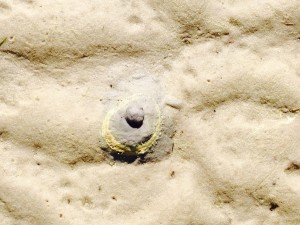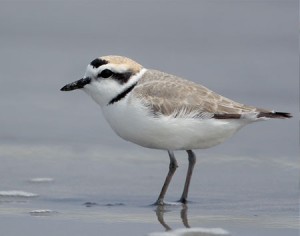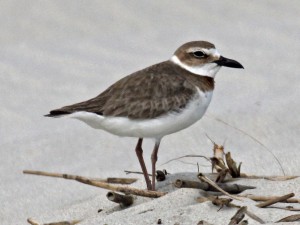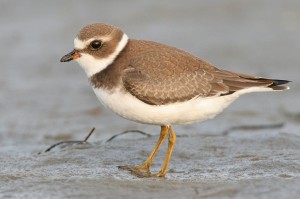Occupy Sandbar: That’s what shorebirds do, because only on the edges of our coastline can they live.
Last week, birders and biologists all over Florida put their binoculars together to see how the original snowbirds are doing on their wintering grounds (which we mostly think of as “our” beaches and sandbars). It’s called the statewide Winter Shorebird Survey. My assigned territory required a kayak trip about a mile off shore to a set of linear, mostly submerged sandbars in Franklin County. There’s really nothing out there for people, but the sand means everything to the birds.
The task I shared with my birding buddy, Mike Miller, was to tally 25 potentially occurring shorebirds, taking special care with the rarest and most imperiled: the American oystercatcher, the red knot, and three kinds of plover.
Once on the reef, we saw so many birds probing and plucking in the shallow water that we had to take turns with the spotting scope to spell our eyes. We set up a grid: Mike would count everything between the boat ramp and the water tower, calling out what he saw. When he counted the dunlin, the most numerous little shorebird on the reef, I’d have a long time to wait and look around. “Ten.” Pause. “Twenty,” he reported. “Another 30.” Pause. Silence.
“Take your time,” I’d say, shifting from foot to foot on the sand, enjoying the sun on my back. Enjoying my great good luck to be out there at all. Then it would be my turn to count.
It took us four hours to tot up the several thousand birds taking refuge there at low tide. Our conservative estimate of dunlins was 1300 individuals. We saw more marbled godwits (those glorious cinnamon feathered beauties!) than I’ve ever seen in one place: 307.
I love all the shorebirds, but my current favorites are the plovers (that preference could change tomorrow, by the way). I’m adding pictures of the four kinds we saw on our count. Plovers are tiny muffins, distinguished by round, dovelike heads, modest bills and short bodies and necks. They run and snatch, rather than walk and probe for their prey. You find them scattered over the drier sand flats, inspecting the ground for insects, worms, or crustaceans. Aren’t they the best?
But believe me, plovers aren’t as distinctive as these images imply when the wind is shaking your spotting scope and the tide is aslosh at your feet.
To spend quality time with plovers, I like to hunker down in their habitat, fade into the sand, and watch what they do. But not on the Winter Shorebird survey. Three kinds of plover are in particular need of protection, and so we had to record extra data when we’d spot a snowy, Wilson’s or piping plover.
Sometimes I get so sad and anxious about the state of our planet, about all the ways humans take and take and take. Only a few years ago, a Tallahassee developer proposed plans to develop this very set of sandbars into condos. With septic tanks. The Audubon Society put up the bucks to buy the reef and saved it for those who cannot live without it.
During the shorebird survey, I thought about how it shouldn’t be up to just a few to protect all this glory. I thought of the lovely markings of the plovers, the dashes of color and little birds’ necks, ringed, according to species. I thought of the plovers’ 65-million year kinship with the coast.
Then I saw how the Earth is still playing with beauty, even today. As I walked back to my boat, I was delighted by the patterns of pine pollen floated across Apalachee Bay from Dog Island.
 Sandy ripples and worm castles had captured the pollen as the tide fell, so like the circlets of feathers on the plovers. Earth is still in charge of beauty. How about we lend her a hand?
Sandy ripples and worm castles had captured the pollen as the tide fell, so like the circlets of feathers on the plovers. Earth is still in charge of beauty. How about we lend her a hand?






Ilove reading these
Beautiful, Sue. Thank you for lending your hand and heart to Earth and her glorious critters!
I appreciate so that you are out there watching and counting and that you describe your experiences so beautifully for us. I love those little plovers with their short but lightning fast legs. Thank you for helping me see their subtle differences.
Sounds pretty amazing. You guys got some great shots too!
beautiful shots of the plovers!
Thank you Susan for your words of wisdom and inspiration! Thank you also for your good efforts and pictures of these precious little beings!!! My husband and I love to go to Dog Island and enjoy seeing a vast array of creatures, all of which play an important role in nature… We are lucky indeed to witness these natural wonders!
Wonderful pictures of the plovers and the ripples. What would we do without plovers, so beautiful and energetic! Thanks for your thoughts as well, always right on inspirational. I look forward to your talk to the St. Vincent Island enthusiasts next week.
You know, I’ve seen plovers before, but only in a superficial way. I love the way you describe them: “Plovers are tiny muffins, distinguished by round, dovelike heads, modest bills and short bodies and necks. They run and snatch, rather than walk and probe for their prey. You find them scattered over the drier sand flats, inspecting the ground for insects, worms, or crustaceans. Aren’t they the best?”
Tiny muffins! A perfect word; not sure if it’s a birding word or just the best word. Knowledge really helps create a deeper affinity for life around me. Thank you, Susan, for opening my eyes and heart more to these precious shorebirds!
I made up that metaphor myself, Reenie! That’s just how they look to me. I’m glad you are liking these pieces! So much
Thank you, Virginia! I’m looking forward to Sunday!
I’m so glad to hear this from you, Linda!
Thanks, pat!
It’s my privilege, Susan, and I’m you like…
Thanks, dear friend!
Means a lot to hear this, Lynne!
I can’t take credit, David….